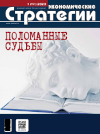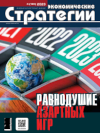Strategic Prospects of the Demographic Component of Russia’s National Strength
DOI: 10.33917/es-5.191.2023.38-53
Demographic situation largely determines the strategic prospects of our country in the context of fierce multifactorial competition between various countries of the world and their bilateral and multilateral alliances. The ar ticle examines dynamics of the Russian population trends, individual causes of male excess mor tality, the main factors for increasing the birth rate and also provides a quantitative assessment of the ef fectiveness of some of the above. To assess the consequences an agent-based demographic model of Russia was used and a sof tware package, developed jointly with researchers from China, was applied to make a long-term forecast of our country’s population.
References:
1. Putin zayavil, chto rossiyan dolzhno byt’ bol’she, i oni dolzhny byt’ zdorovy [Putin Said that there Should be More Russians, and they Should be Healthy].TASS, 2022, 9 iyunya, available at: https://tass.ru/obschestvo/14871349
2. Asel’ Gereikhanova. Vladimir Putin poruchil v 2023 godu dobit’sya rosta zarplat, rozhdaemosti i prodolzhitel’nosti zhizni [Vladimir Putin Instructed to Achieve an Increase in Wages, birth Rates and Life Expectancy in 2023]. Rossiiskaya gazeta, 2023, 29 yanvarya, available at: https://rg.ru/2023/01/29/zadachidlia-razvitiia.html
3. Demografiya [Demography]. Rosstat, available at: https://rosstat.gov.ru/folder/12781
4. Andreev E. M., Darskii L. E., Khar’kova T. L. Naselenie Sovetskogo Soyuza: 1922–1991 [Population of the Soviet Union: 1922–1991]. Moscow, Nauka, 1993.
5. Rosstat [Website], available at: https://rosstat.gov.ru
6. Makarov V. L., Il’in N. I., Bakhtizin A. R., Khabriev B. R. Natsional’naya sila stran mira: otsenka i prognoz [National Strength of the Countries in the World:
Evaluation and Forecast]. Ekonomicheskie strategii, 2022, no 6(186), pp. 38–51, DOI: https://doi.org/10.33917/es-6.186.2022.38-51
7. Vsemirnyi bank [Website], available at: https://data.worldbank.org
8. Uroven’ smertnosti: Sravnitel’naya informatsiya po stranam [Mortality Rates: Comparative Information by Country], available at: https://www.cia.gov/the-world-factbook/field/death-rate/country-comparison
9. Demografiya: Prognoz [Demographics: Forecast], available at: https://www.agents.media/demografia-prognoz
10. Makarov V. L., Nigmatulin R. I., Il’in N. I., Bakhtizin A. R., Sushko E. D., Sidorenko M.Yu. Tsifrovoi dvoinik (iskusstvennoe obshchestvo) sotsial’noekonomicheskoi
sistemy Rossii — platforma dlya eksperimentov v sfere upravleniya demograficheskimi protsessami [The Digital Twin (Artificial Society) of the Socio-Economic System of Russia is a Platform for Experiments in the Field of Managing Demographic Processes]. Ekonomicheskie strategii, 2022, no
2(182), pp. 6–19, DOI: https://doi.org/10.33917/es-2.182.2022.6-19.
11. Chislo rodivshikhsya (bez mertvorozhdennykh) za god [Number of Births (Excluding Stillbirths) per Year]. EMISS. Gosudarstvennaya statistika, available at: https://www.fedstat.ru/indicator/31606














